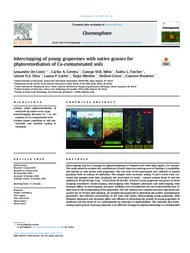Intercropping of young grapevines with native grasses for phytoremediation of Cu-contaminated soils.
Intercropping of young grapevines with native grasses for phytoremediation of Cu-contaminated soils.
Author(s): DE CONTI, L.; CERETTA, C. A.; MELO, G. W. B. de; TIECHER, T. L.; SILVA, L. O. S.; GARLET, L. P.; MIMMO, T.; CESCO, S.; BRUNETTO, G.
Summary: Intercropping may be a strategy for phytoremediation of vineyard soils with high copper (Cu) content. The study aimed to evaluate the contribution of South American native grasses in limiting Cu availability and toxicity in soils grown with grapevines. The soil used in the experiment was collected in natural grassland with no history of cultivation. The samples were air-dried; acidity, P and K levels were corrected and samples were then incubated. We used three Cu levels - natural content (Dose 0) and the addition of 40 and 80 mg Cu kg1 of soil (Dose 40 and 80). At each Cu dose, grapevine was grown in three cropping treatments: monocropping, intercropping with Paspalum plicatulum and intercropping with Axonopus affinis. In intercropping, two grass seedlings were transplanted into each experimental unit 35 days prior to the transplanting of the grapevines. The soil solution was sampled and ionic speciation was carried out. At 70 days after planting, we sampled the grapevines to determine dry matter, morphological parameters and nutrient concentration in the roots and shoots. Intercropping young grapevines with Paspalum plicatulum and Axonopus affinis was efficient in promoting the growth of young grapevines at moderate and low levels of Cu contamination by reducing Cu bioavailability. This indicates that maintaining native grasses in young vineyards is an effective strategy for phytoremediating Cu- contaminated. Keywords: Copper availability Vitis vinifera Ionic speciation Native plants Heavy metal
Publication year: 2018
Types of publication: Journal article
Unit: Embrapa Grape & Wine
Observation
Some of Embrapa's publications are published as ePub files. To read them, use or download one of the following free software options to your computer or mobile device. Android: Google Play Books; IOS: iBooks; Windows and Linux: Calibre.
Access other publications
Access the Agricultural Research Database (BDPA) to consult Embrapa's full library collection and records.
Visit Embrapa Bookstore to purchase books and other publications sold by Embrapa.

